  
KickBoxing
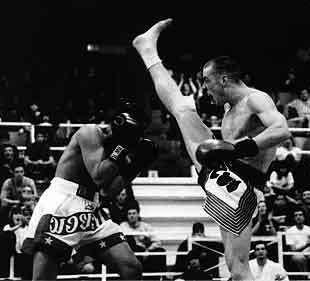
KickBoxing is a form in which
"creation of a moment is
'every moment' !". It frees you from limitations and lets you express your Martial forms fully and powerfully.
What is Kickboxing?
Kick-Boxing has been created in the early seventies, by mixing foot techniques from karate and fist techniques from boxing. There are four different types of combat competitions in
Kickboxing :
Semi-Contact, Full-Contact and Low-Kick. Musical Forms are the fifth type of
competition.
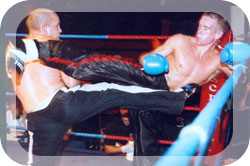 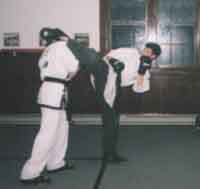
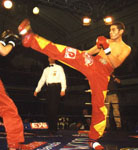
Kickboxing is:
* A combat sport: we use feet and fist obeying precise rules.
* A true sport: technical knowledge, a good physical condition, tactical intelligence, ethic qualities, agility and a lot of will are required.
* A safe sport: to minimise the risk of injury the competitors are forced to wear protection for feet and head, shin guards, safety gloves, mouth guards, groin guards for men and Chest protection for women.
* A modern sport: developed following the latest knowledge in sports medicine and still open to innovation and research.
KICKBOXING is becoming a popular martial art for all ages. It has two major systems, Full Contact and Semi-contact, both are a
continuous fighting system.
Full contact is defined by contact where no punch or kick is pulled back but full force is used. Semi-contact is defined by having little force behind the punches and kicks, thus virtually eradicating any injuries to the contestants. The Semi-contact system is used for ages 7 years up to 16 years of age.
Full Contact Karate or Kickboxing?
“Full Contact Karate,” “Kickboxing,” “Karate”! What do these terms actually mean? Karate/Kickboxing (KK magazine) has, after considerable thought on and research of the martial arts in the Unites States as well as foreign countries, decided that the three non-synomous terms be placed in their proper perspective.
“Karate” in the simplest translation means “empty hands”. Therefore, Full Contact Karate implies that all of one’s natural weapons are to be utilized in striking any and all vulnerable areas of an opponent. There would be no rules and any and all techniques would be allowed. However, Full Contact Karate as currently practiced in the United States is anything but this as the rules and regulations limit techniques to be used and areas to be attacked. Both the hands and feet are padded and almost all the hand techniques utilized have been borrowed from conventional boxing. The only actual Karate techniques remaining are the kicks which themselves are limited. So, what we have is “Kickboxing.”
The closest thing to Full Contact Karate practiced and exhibited to the public would be Thai Kickboxing. The Thailand fighters have trained long and hard hours toughing their legs and shins by kicking stationary objects which created callouses so hard that they could break baseball bats and bottles without pain or injury. Japanese kickboxers also are more liberal with the techniques allowed.
In late 1969, a version of Contact Karate was introduced in the United States. Joe Lewis, an advocate of realism and physical conditional as well as being at the top of the point tournament Karate ranks, was quick to take advance of the opportunity to prove that he was the number one for real as well for fun (point, no contact Karate).Lewis opposed a tough competitor named Greg Baines. The fight, which took place in California, was billed as “Full Contact Karate”, as knee and elbows were allowed. However, traditional Karateists rasied so much opposition that the term “Kickboxing” was adopted.
Other matches followed in Texas, New Mexico, New York as well as in California. By 1972, the rules has been revised, eliminating knees and elbows. Thus, the only semblance to Full Contact Karate left was the kicking. In 1975, Mike Anderson revived and assumed the Full Contact Karate name when he promoted the so-called first World Full Contact Karate Championship. But again the only Full Contact Karate techniques allowed were the limited kicks. However, since that time the term “Full Contact Karate” has prevailed.
In Japan, karate and kickboxing are separate and distinct, each with its own governing bodies. Canadians also distinguish between the two arts. The
interchangeability of the Karate, Full Contact Karate and Kickboxing terms have also served to confuse the Public. Non-Karateists as well as Karateists see advertisements for the events and are totally confused as to what they are going to actually see. Once they purchase a ticket to the event expecting to see one thing and in facts see another, they become disillusioned or enraged and probably will never attend another like event. Also, prospective students and their parents are misled by the terms and it is impossible to determine the effects on the karate school enrollment. At this stage of the game as we see it (KK magazine), Karate will refer to the traditional martial arts practiced in the Karate school. The term “tournament Karate” will be added to cover the non contact sport competition. “Full Contact Karate will refer to the all out, no-holds barred self-defence. And last but not least, whenever a martial arts practitioner puts on gloves, utilizes boxing techniques along with limited kicking techniques and has techniques governed by rules and regulations, the term “Kickboxing” will be utilized.
Types Of
KickBoxing
Full Contact - Kick-Boxing
[in America] :
Joe Lewis was
the only one experimenting with kickboxing in 60's , up until 1970.
Full-contact as a sport originated in the USA in the early 1970s. The system utilizes
punches, kicks and foot sweep techniques, all kicks were allowed ( in
some low kicks were barred ie, kicks must be delivered above the waist). Fights are fought from 3 to 12 rounds, consisting of two-minutes each round with one-minute rest period in between.
Fighters must wear protective foot boots, shin pads, full-contact trousers, groin protector, gum shield, boxing gloves and hand wrappings. Each contestant are required to perform a minimum of 8 kicks per round, a fighter failing to perform the minimum of kicks will lose a point from that
round [Note : Some rules were six kicks per round and some were no kicks
per round.]. Also Joe Lewis fought many
matches in 1970 and 1971 were you could knee, elbow or kick the legs.
There are variations to this system with some organizations allowing you to kick to a contestant leg and others do not have a minimum kick rule.
In a Full-Contact contest a fighter can punch to a contestant face or body using any allowable boxing technique. Kicks must be delivered by using your instep, heel, ball or the knife-edge of the feet, sweeps can also be used.
I.K.B.F. Kickboxing rules
Muay Thai -[ "Thai Kick Boxing or Thai
Boxing" ] :

 
Muay Thai (known in the West as Thai boxing) originated in Thailand and dates back thousands of years. The system utilises punches, elbows, knees, kicks and grappling techniques.
Each part of a Thai fighters body is a potential lethal weapon, making it the most brutal of ring sports. Fights are fought over five three-minute rounds with a two-minute rest period in between, boxing gloves, groin protector, gum shield, Thai boxing trunks, hand wrappings and cotton anklet on each foot is worn.
In a Muay Thai contest a fighter can kick to a contestant's leg, body or head using the shin, knee or instep, punch or elbow to the face or body. Although punches can result in a knockout they do not score high points from Thai Judges who are looking for the most spectacular/effective attack/defence from a contestant with the use of kicks, knees and elbow strikes. Muay Thai rules
In Europe, Muay Thai Kick-Boxing is fought under modified rules (one of the difference is that no elbows or knees are allowed to a contestant's head)
In Thai Land students/Fighters stay at a Muay Thai School to learn the art..
Here is the daily schedule (as in EVERY day):
4:30 PM: Individual stretching and jumping rope
Foot work training on old truck tires
Walking shadow boxing in a circle around the dojo
5:00 Sand bag
5:30 One on one with the teacher in the ring
Weight training (equipment is made from home-made cement and tree branches)
Thai-style tie-up training (the grab the neck; knee in the ribs thing)
More shadow boxing...
Sit ups / push ups / pull-ups / jumping knee ups / kick the 4x4 post etc.
The Art of Muay Thai
Muay Thai is a martial art of fighting with one's own bare fists utilising elbows, knees, feet and fists as one's weapons. It cannot be traced back for when Muay Thai took place. However, it can be assumed that Muay Thai has been practiced since the beginning of Thai history. In the old days, Asian men of Mongolian descendant from China down to the Malaya peninsular had been through wars by fighting face to face with enemies. Thus, the art of fighting has been developed as an element of personal capability. The Caucasian counterparts in Europe, however, have concentrated more in developing weapons than personal capability to fight. Consequently, martial art has been rather advanced in this part of the world, especially in Thailand; most of the Kings and great warriors went to the wars by fighting fist with enemies.
Muay Thai has been one of the most efficient ways to fight. Since modern technologies did not exist in the ancient times, Thai children did not have mechanical toys to play with. Instead, they used their bodies to play games. Those simple games served as basic exercises for Muay Thai. They made parts of the bodies ready. Muay Thai involves all parts of the body. The students of Muay Thai learn about the body's weak points and understand how to exercise one's physical parts. 'Nawa-attawut' or the 9 principal weapons in Muay Thai include head, two fists, two elbows, two knees, and two feet. In addition, there are combination weapons which are two shoulders, arms, bottom and the outer parts of the ankles: The practice of using both the principal weapons and the combination weapons in Muay Thai requires not only hard working but proper steps and tough endurance.
The Practice of Ancient Muay Thai
There was 3 major cities well known of Muay Thai camps: Chaiya, Korat and Lopburi. Chaiya was a front town for army drafting. Muay Thai from these 3 cities have been recognised since the Reign of King Rama V for their excellent capability. The 3 towns were named as Muay Thai cities. Prominent boxers from these towns were brought in to perform at the royal cremation of Kromkoonmarupongsiripat. The 3 top boxers who were honoured with the title of 'Muen' were Muen Muey Mee Chue (Plong Chumnongtong from Chaiya), Muen Mua Man (Kling from Lopburi), and Muen Cha-ngat Chueng Bok (Daeng Yhaiprasert from Korat). There was an old saying glorifying tactic and style of these three boxers, Korat fists, wit from Lopburi, good beat Chaiya.
These three Muen’s displayed the exotic styles and techniques of Muay Thai as skilfully as their titles signified. Somdet Phraputhacharn (Som Chanano), the former Abbot of Wat Sudhasthepwararam has related of a Muay Thai master from Chaiya as follows: 'Mr. Nil, a boxing master from Chaiya put powder on his face sitting crossed 1egged flat on a rice mortar and letting his 3 pupils box at him. He was able to protect himself from getting hit on the face and not losing his balance falling off the mortar. The practice of Muay Thai is done in steps starting with 'Pong Pat Pid Poed' (Guard, push, close, open), followed by 'Loh Lo Lop Leak' Lure and evade), 'Tum Tup Chap Huck' (Pull down and knock down) and 'Prakop Prakup Chup Runk Khao Khan Lak Dud Kan Khaw' as the last step of defeating an opponent. Above all a boxer has to be trained the skill of 'Yang Sam Khum' which is the footing rhythm in Muay Thai movement.
Each master has his own style of 'Yang Sam Khum'. The perfect movement is the technique that can twist the counter action, action to be attacking movement in the most efficient and subtle manner. Luang Wisandaroonkorn who had received training from Phra Chaiyachockechonchena (oon) invented the well-known style. This style was the same as the one of the abbot of Wat Tung chang who had been recognised as the great master of Muay Thai from Chaiya. The primary position in "Yang Sam Lum" was to set up the fist. The basic principle was trying to swing yourself to be as a thin target as possible in order to avoid the attack from the opponent while skilfully fighting back. The sparring equipment in the former times was not as advanced as today. Simple materials from nature were adapted and applied into practice, for instance, the binding of the fists. After listening to the master, a student used a loin cloth called 'Pa Khao Ma' hung from his neck using the back of his hands to bind the cloth round his fists.
One hand was raised for about 8-12 inches away from the forehead amid the eyebrows. Another hand was up at chin level; elbow hung 2-3 inches closely to the body to protect the side when getting kicked at. When the hands were set ready, the same foot as the hand at forehead level would step out followed by the punching from that same side fist. Alternative fists were punched out in accordance with the stepping feet. That is, left fist punched. Other materials were also used in sparring. The great master Kimseng Taweesidh used coconut shell to make gloves. Some used limes by tying 10 limes with thread 6 inches apart onto the bamboo rail at the height of one's throat and let trainee punch with fists, elbow, arms without getting the limes bounced back at his face or thread up or limes dropped off the stems.
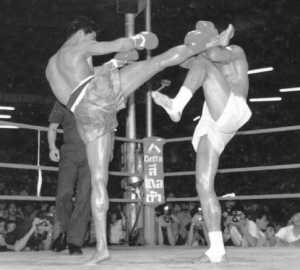
After the boxing practice, the protection of the upper body from head to waist would be trained and tested. The trainee would put powder mixed with water on his face and sat cross-legged flat on a rice mortar. Another trainee wearing gloves simply sewn up from canvas piece with fingers all exposed, would do the trainee sitting on the mortar. The sitting trainee would have to protect himself from not falling off the mortar and not letting the powder shed off his face so much. For the feet training, a trainee had to jog in the water at ankle level first leaving the ripple line behind each wading step, then jogging further in water at front leg level.
For kicking practice, a banana trunk of 5-6 inches in diameter about 3 feet long was used as a sandbag. A trainee had to keep kicking the trunk with alternate feet so as not let the trunk drop. Then the trunk could be changed to 4 feet length for higher kicking practice. The skilful trainers in this training method were Mr.Tub Chumko from Korat and Master Nual from Lopburi. When the sandbag came in to use for punching and kicking practice, Master Charoon Taweesidh told his students, 'do anything you like with it, but keep the bag on a 30 degree angle or more for 3-5 minutes. They would start with a bag filled with wooden scrape and later on they'd advance to a real sand filled bag.
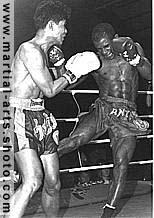
Legends :
There are modern legendary figures of Muay Thai as well as those from the past. Like Pol Prapradang - the 'Willd Boar'. His boxing record speaks for itself; 350 bouts, both international and Muay Thai styles. He was never knocked down or given the count during his extraordinary fighting career. This record is even more spectacular since it was built by often fighting in weight classes much heavier than his own. He was a bantamweight but to find a fight, he often fought in the welterweight division. The "Wild Boar" was also a fabled figure for his ceremonial dance before each fight. Whoever has seen it, has said that his 'Hanuman Tob Yoong' - which means 'The Monkey God slapping the mosquito' - boxing dance had no equal. To add to this record, Pol Prapradang was also the first ever Thai Boxer to be internationally ranked in the bantamweight division of international boxing.
"Aerobic or cardiovascular ("cardio")
kickboxing" :
Currently, one popular form of kickboxing is known as "Aerobic or cardiovascular ("cardio")
kickboxing", which combines elements of boxing, martial arts, and aerobics to provide overall physical conditioning and toning. Unlike other types of kickboxing, cardio kickboxing does not involve physical contact between competitors - it's a cardiovascular workout that's done because of its many benefits to the body.
Cardio kickboxing classes are usually comprised of 10 to 15 minutes of warm-ups, which may include stretching and traditional exercises such as jumping jacks and push-ups; then about a 30-minute kickboxing session that includes movements such as knee strikes, kicks, and punches. Some instructors may use equipment like punching bags or jump ropes.
After this, at least 5 minutes should be devoted to cooling down, followed by about 10 minutes of stretching and muscle conditioning. Stretching is really important because beginners are prone to strained ("pulled") muscles, and slow, proper stretching helps relax muscles after vigorous activity and prevent injury.
"Fitness Kickboxing" is sweeping the country as America's fastest growing aerobic workout. You'll get all the sweat and intensity of aerobics with an introduction to the basics of martial arts.
History of KickBoxing :
Full Contact Kick-boxing developed through a combination of Muay Thai and other martial art influences. It was aided in its rise, as were all martial arts at the time, when Bruce Lee exploded onto the big screen. The first time anything resembling what we now know as, Full Contact Kick-boxing began in the United States in the early 1970's as Full Contact Karate.
For some Karate wasn't enough. Some fighters wanted to taste the buzz of a Full Contact bout but restrained because of the injury risk and the rigid rules. Full Contact Karate soon evolved. Before too long, this step towards a full-contact sport - with timed rounds - became Full Contact Karate. In September 1974, in Los Angeles, the first ever World Championships of Full Contact Karate were hosted. At that time Karate's own sanctioning body, the PKA, provided the official nod that was required. The bouts took place on a standard karate surface (no ring). Some of the best traditional Karate fighters of North America Karate tried their hand at this fresh take on their ancient art. It wasn't until the late 1970's that the sport moved into a boxing ring. Initially, there were only weight 4 divisions. The first Full Contact World Champions where Jeff Smith, Joe Lewis, Bill Wallace & Isuena Duenas. The first three names remain legends today.
From 1974 until 1985, the PKA was the most recognised world-wide sanctioning group, even though it operated mainly through the USA. Don & Judy Quine, along with Joe Corley, helped it on it's way and were instrumental in establishing the first links with television. Their contract with the American TV network ESPN helped take the burgeoning sport to a wider audience. The PKA developed the first fighter's ratings systems and presented their champions with a very real and very high profile. Jean-Yves Theriault, Brad Hefton, Jerry Trimble, Steve Shepard and others became the first stars of this new regulated sport.
The roots of the sport in Europe were planted in Germany. In 1975, an amateur organisation to rival the PKA appeared. The WAKO (WORLD ALL STYLE KARATE ORGANIZATION) was created by Georges Bruckner and was the only international amateur federation in Europe. Over the next decade a myriad of sanctioning bodies came and went - all claiming to represent the best interests of the fighters and the sport. WAKO today remains the leading amateur federation in kickboxing. WAKO was taken over by Ennio Falsoni, an Italian, a few years later. Under the guidance of Mike Anderson a professional branch - the PKO (PROFESSIONAL KICKBOXING ORGANIZATION) - soon emerged. It was shortlived, though, when Anderson retired in 1991 and the IKL (INTERNATIONAL KICKBOXING LEAGUE) became the professional division of the WAKO. The IKL only lasted several years.
The WORLD KICKBOXING ASSOCIATION (WKA) was created in 1976 by Howard Hanson, a Shorin Ryu Karate black belt and student of Mike Stone. It developed the field of low kicks thanks to some strong Asian connections and good promotions in Japan. The WKA also prospered in Europe. Champions like Rob Kaman, Fred Royers, Ivan Sprang and Ronnie Green emerged over a decade ago and remain planted in the memory. When Howard HANSON sold the WKA to Canadian Dale Floyd in 1991 it’s North American activity started to fade. Newly appointed European Directors Fred Royers from Holland and Jean-Paul Maillet from France left in January 1994 when Paul Ingrahm took over the prestigious federation and established its World headquarters in the UK. At the time, WKA was the second largest professional sanctioning organisation in the World.
When legal problems sent the PKA to the wall in 1985, 5 major USA based promoters and PKA executives decided to create a new body. On July 16th 1986, the International Sport Kickboxing Association was born. Mike Sawyer, Karyn Turner, Tony Thompson, John Worley and Scott Coker where the first ISKA Directors in the USA. Most of the major PKA promoters began sanctioning their events with the ISKA and several joined its administration. Major title bouts featuring the sport’s finest fighters were broadcast during 1986 on ESPN television network, and helped bring credibility and recognition to this new association. At the time, the intercontinental links where the weak part of those sanctioning bodies as WAKO was virtually non existent anywhere other than Europe and WKA was almost only active in Asia. A European arm of ISKA was going to prove vital. In October 1986 Olivier Muller, Jérome Canabate and Mohamed Hosseini were appointed ISKA European Directors. American Richard Mayor oversaw the establishment of this European wing as European President between 1986 and 1988. By 1991, the worldwide control of the ISKA was shared by two co-chairmen - SAWYER and MULLER. It was their work that secured international TV coverage, that began to unite separate organisations springing up world-wide and took responsibility for sanctioning and grading. During all these years, Thaiboxing remained the main fighting sport in Asia and is still controlled by the Thailand government. All sanctioning bodies sanction Muay-Thai titles but the WMTC remains the most credible organisation in Thai boxing.
From 1996 til 98 the ISKA was headed by Olivier Muller. In two years he revitalised and added fresh impetuous to a management heavy organisation - an organisation that in the early nineties had began to flag - and turned it into one that operated 60% of the world-wide kick-boxing business.
ISKA to WKN. But as before, minor squabbles and petty professional jealousies have led to a split. The younger blood that led the European charge has become disillusioned with the incumbent American leaders and a new fresh body (the WKN) evolved in late 1996 as a subsidiary of ISKA to capture another part of the market. Unfortunatley the Americans saw the WKN as a threat and in late 1998 the organisations split. The departure of Muller from the scene was iminent. A tight, young team runs the WKN, chaired by Frenchman Stephane Carbrerra. Other big names in the world of Kick-Boxing have followed. (See Contacts). Already the organisation has seen their fighters on one Don King under-card with more to follow soon. Rather than money from sanctioning fees being syphoned into a slush fund for a few big cats at the top, all monies will go into a central pot that is used to promote and boost smaller and little established fighters and events. Crucially, it will be non-profit making. It is sad that the split should have happened but confirms that a bright new dawn is guaranteed.

THE CONFUSION OVER THE NAME OF 'KICKBOXING!'
The sport of Kickboxing in North America has had a short (when compared to Boxing) but very interesting history. During the few short decades of the sports existance on this continent, it's history is filled with many unpredictable twists, turns and surprises. This is mainly due to the sports early history which was not properly recorded and/or contains misinformation, fallacies, linguistic problems, and a heap of politics, coupled with the current history which contains people who all have different opinions as to where the disciplines should be. The result of all this has created mixed feelings between the different ring oriented Martial Arts disciplines (different because of each type of 'rules' each discipline allows or follows in competition: Full Contact Karate - only allows kicks above the waist, Kickboxing - which allows kicks into the legs, Muay Thai - which follows several sets of rules allowing punches, kicks and knee attacks, to also allowing the use of elbows as weapons). The mixed feelings have resulted in less than die hard support from the media (there have been memo's sent out at some of North America's largest television channels to avoid programming any Full Contact / Kickboxing / Muay Thai). This is why "Kickboxing" is not seen as often on television as it was in the late 1970's and 1980's. In terms of ticket sales, even the general public does not support the disciplines the way promoters would like. At times, the infighting between the disciplines seems to be a vicious circle; with each discipline criticizing the other(s) to try and benefit their own. After some investigation, the initial problem arises over the generic use of the term "Kickboxing", but whose fault is this? The North American media groups all different Martial Arts styles using boxing gloves under the heading of "Kickboxing". Major North American Martial Arts magazines (such as Black Belt, Inside Kung Fu, etc.) use the term "Kickboxing" in many imaginative ways: Full Contact Karate Rules (American Kickboxing), San Shou (Chinese Kickboxing), Bando (Burmese Kickboxing), Boxe Francaise- Savate (French Kickboxing), Muay Thai (Thai Kickboxing), and now there is even Cardio- Kickboxing* and the Lord above forbid, Tae Bo (hilarious isn't it? By the way, Mr. Blanks was never a 'World Kickboxing Champion' and to his credit, he only claims to be a 'World Martial Arts Champion'. I still have video of him in his professional boxing career. No disrespect, but I understand why he has stuck with Tae Bo). Today there is also a myriad of watered down aerobic Kickboxing programs taught by unqualified, soft bodied, and self-proclaimed "Kickboxers" who have never done a serious thing in or for the sport and different disciplines. There are so many Kickboxing (to get into shape) videos, that it is now embarrassing. There are even claims by these videos male and female hosts that they are so 'deadly in the ring' that after one fight they proclaim themselves to be 'The Kickboxing Guru' for all to follow. The fad has also now meant a quick and easy buck for those claiming they can certify people to become 'Kickboxing', 'Cardio-whatever' instructors. Most doing the certifying have no formal training in Kickboxing and/or have no certification themselves. There is one huge certification organization that comes to mind in Florida USA for prostituting the disciplines for a quick buck (but believe me they are not the only one guilty of this). For a fee, one can participate with a large crowd of people for a few hours in a workshop and voila - become a 'certified' Kickboxing instructor. The problem is, claim to be a instructor in any style of Karate after a few short hours in a workshop atmosphere and you will be criticized by authentic Karateka (practitioners) for not having put your time in, graded and followed the curriculum to earn the right to be an 'instructor'. Talk about a double standard now that the 'shoe is on the other foot', it is now all right by the Karateka and some organizations (not by me and many other partisan Full Contact/Kickboxing and Muay Thai instructors) to prostitute the Kickboxing disciplines (for the big buck!).
FAQ :
HOW DO YOU FIGHT AGAINST A GRAPPLER?
Question: How do you fight against a grappler, if you want to do stand up fighting.
Answer: You need to have a strong stance, try to avoid kicking techniques because when you kick, you're not completely balanced. Therefore, you could be taken down. A grappler wants to take you to the ground. Try to use hand strikes. The key is to keep the grappler from taking you off-balance. If you are close enough, use elbows and knees. Remember that you have to be good in all of the four fighting zones: kicking, punching, throws, and take-downs (also called trapping and ground fighting). You have to be a well rounded martial artists because the true test to how good you are at defending yourself is how well you fight when you are out of your element. There are no rules on the street, therefore you had better know what works if you want to survive, because you don't want to be a victim.
Jumping kicks are fun to watch and flashy, but in most real world scenarios against someone who is trained, you will get you into trouble in a real fight. Almost all fights no matter if you are a seasoned pro or a beginner end up on the ground. What happens in the movies is NOT the norm. Learn some grappling techniques and holds in this case, it will only help you out. As for wanting to learn to do better jumping kicks, by all means do it. It works great in forms competitions and will help build stamina if performed often but avoid using them in fights, even the average Joe on the street can avoid one because of the time it takes to load up if you are not 100% used to throwing them. Try enrolling in gymnastics, you'll never learn how to better your acrobatic skills then in that class and if you've noticed, they can get some serious height without a lot of power or speed. But it does take time...
Do jumping drills in order to strengthen the muscles around bone and knee. Exercises where jumping on top of boxes from a stationary position with both one and two foot take offs. Every week built a higher platform to jump up on. As far as using jumping kicks in self defense goes I agree its not likely used. However using jumping kicks in sparring and kickboxing adds technique and another weapon to your game.
Some of the most prolific empty hand fighters in the world have come from Thailand. Their training methods alone make for a well conditioned and physically fit fighting machine, offensive in approach, rather than defensive. Their attitude of no surrender in the ring is a legacy from their past. This attitude has of course been shaped by their history, a history chequered by attacks on their culture, their towns and cities. The collective unconscious of the Thai race has been moulded and shaped by their history. A history which is alas, incomplete. Thailand’s early historical records were lost in 1767 when Burma laid siege to Thailand’s ancient capital Ayuddhaya.
Muay Thai (Thai Boxing) can trace it's origins 2,000 years ago to the ancient and nomadic tribes that wandered through Central and South-East Asia.
Eventually they settled in the part of the world known now as Thailand and, being forced to defend themselves against their neighbors, developed a system of warfare which included Krabi-Krabong (traditional weapons) and Muay Chao Chur from which the sport of Muay Thai later evolved.
Both systems of combat proved effective in countless battles. During the periods of peace the soldiers would fight for sport, and it was from this era that the modern sport of Muay Thai evolved. It's popularity in Thailand is well known, and is now considered it's national sport.
Thai Boxing or Muay Thai is the martial art, which originated from the ancient Thai weapons art of Krabi Krabong. Muay Thai evolved over hundreds of years ago as a back up to when a warrior lost his weapons in battle and had to resort to using powerful kicks, punches elbows and knees. In 1650 when the King of Siam was captured by the Burmese and offered his freedom if he could defeat the Burmese champions. He successfully defeated several of the finest Burmese boxers, and won his countries' freedom. Thai Boxing evolved into a national sport with boxing gloves and a standard set of rules and regulations established to ensure the safety of the competitors. Many people do not know the difference between Thai Boxing and Kickboxing. Thai Boxing differs from Kick boxing in several respects. Kick boxing originated approximately thirty years ago when the Japanese began developing their own methods of incorporating Muay Thai and karate. Eventually, the sport came to the notice of the American people who made kickboxing popular throughout the world. Kickboxing is similar to Muay Thai using hands and feet but omitting the knees, elbows, and clinch work which is an integral part of Thai Boxing. As a self-defense Muay Thai's powerful kicks, knees and elbows make it second to none in street combat.
Muay Thai is an old Thai martial art system which was developed in the battlefields by ancient warriors of Thailand over 2000 years ago. In modern time, Muay Thai became a ring-sport of choice receiving serious attention in the 1920's; thus, making Thailand famous for it's ring sport. Today, Muay Thai or Thai-Boxing is considered the King of all Ring Sports. It is taught to the Thai Military, the U.S. SEAL teams, Special forces, CIA, and to the Secret Service. Because of it's outstanding effectiveness in tight quarters with minimum movements, Thai-Boxing has become the primary weapon for Dynamic Entry Persons on Swat and Tactical Teams.
Thai Boxing consists of four major components totaling nine weapons of choice. This is called Nawa-attawut, which means that 9 principle weapons of Muay Thai. These weapons include strikes from one's head, (2) fists, (2) elbows, (2) knees, and (2) feet; In addition, there are combination weapons used which are (2) shoulders, (2) arms, and the bottom & outer parts of the ankles. The practice of using both the principal weapons and the combination weapons requires not only hard working, but proper steps and tough endurance.
Muay Thai practitioners do not earn belt colors typical of Karate and Tae Kwon Do schools. Instead, Muay Thai practitioners test their skills in the ring. In fact, the only belts Thai boxers are concerned with are the Lumphini Stadium and the Ratchadamnoen Stadium Championship belts. Most of the Thai fighters begin their careers as early as six or seven years of age, and will fight in major stadiums in their early teens. This type of intensive training has allowed Thai boxers to dominate the world in full contact bouts.
Muay Thai did not develop a ground-grappling component because it was developed in the ancient battle fields where there were multiple assailants, who were proficient with the use of sword & dagger fighting. With swords, spears, sticks, shields and hard strikes flying from a multitude of directions, the ground was the last place that you'd want to be. Muay Thai was combined with very fast Thai Weaponry system called Krabi-Krabong.
Another major difference between Muay Thai and other Kickboxing styles is the Thai Round-house kick. It is a rear leg kick, which drawls power from the hips, and strikes it's target with the shins. Conditioning the shins is no fun task, but once the nerves have been conditioned for impact, shins can be used like a club. You have to experience the crushing sensation of a Muay Thai kick to realize and respect the power & superiority as compared to other kick systems which use frontal-leg snaps with their instep. The Thai kick is so effective that it is the only kick really used by Thai boxers in full-contact bouts.
Some people have tried to fight against Muay Thai fighters by prohibiting the use of low kicks, knee strikes and elbows, but this makes me wonder whether they were more concerned with beating the art of Muay Thai or someone of Thai ethnicity. If you want to fight against a Muay Thai fighter, then be prepared to face the style of Nine weapons; Otherwise, it's not really Muay Thai.
Legend of Muay Thai -- "Nai Kanom Thom" :
 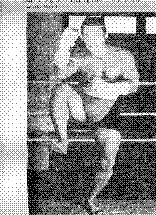
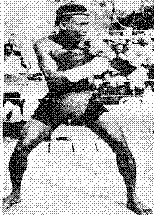 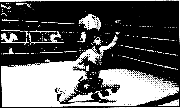
Muay Thai started way back in the medieval ages when wars were fought with bow and arrows, swords and pikes. And in hand-to-hand combat arms, legs, knees, and elbows were also used as weapons. This sport which was included in military training was made famous by King Naresuan 1560 A.D. During one of the many battles between Burma and
Siam, he was captured. The Burmese knew of his prowess as the best unarmed fighter in the realm and gave him a chance to fight with their best for his freedom. Upon his return to Siam he was hailed as a hero and Siamese-style boxing, as it was called then, was soon recognized as a national sport. Boxing in this style reached its zenith of popularity about two hundred years ago, i.e., in the reign of Prachao Sua (King Tiger), when it was indulged in by all classed of the population.
An old Thai legend mentions a fighter named Nai Kanom Thom
who was captured by the Burmese and won freedom after winning barehanded against twelve Burmese gladiators. There is an annual tournament honouring him nowadays. According to the other legend from the 14th century, a fight between two boxers decided who would be the future king. It says that after the death of the old king Sen Muang Mu his sons Fang Keng and Ji Kumkam could not agree about the successor. As the conflict threatened to turn into civil war, the followers of each side agreed to stage a fight which would decide the future king. The fighter from the Ji Kumkam side won and Ji Kumkam thus became king.
At that time fights were very cruel. There were no weight categories and rounds. Fighters were barefoot with their fist wrapped in hemp or cotton bandage. Genital protectors were made of coconut shells. All kinds of kicks and punches were allowed, with few limitations. Among other things training included punching a lemon hitched on a string for focus, kicking and punching palm trees in order to strengthen feet and fists, long distance running, training in water, etc.
A special diet, mainly vegetarian was an obligation. Some techniques from that period remain unchanged until today and they are known as "king Tiger techniques". After World War II, Thai Boxing was changed a lot. Rule modifications transformed it into an attractive fighting sport, and many practice it a self defence or recreation.
Its a Deadly Art ! :
Elements of the traditional system can still be seen in Thailand, particularly in the
practises of Krabi Krabong, a weapons system from which Muay Thai eventually
developed, and in the Sila and Chaiya fighting systems of which very little is know. In fact Chaiya is only practised in its original form by a very small group of individuals in Bangkok, and is being taught by Acharn (Master) Thonglaw Yarlair, now well into his sixties. Archarn Thonglaw is quite clear that the practice of Chaiya is not for sport, but is a serious and dangerous self defence system, and so does not attract the number of students like Muay Thai. The practitioners still practice with hands wrapped in bandages, each being over 15 metres long. Traditionally these bandages were made from the winding sheets of the dead (so as to scare the opponent) but the custom has been abandoned. Training the mind plays as important a role in the Chaiya fighters routine as does the physical, where the adage "use 4 ounces to move a thousand pounds" is put into practice, with the emphasis being on using the opponents strength and aggression against them, rather than your own brute force. With only a handful of students left, it looks as if this very important part of Thailand’s martial arts may die out altogether, and be relegated to the history books, or transform itself into a ritual dance akin to Sila, a fighting system indigenous to Thailand, which is more often than not practised as a dance. It bears remarkable similarities to Silat as practised in neighbouring Indonesia and Malaysia, and is technically just as destructive.
All of these arts have one thing in common, in that they are not so much defensive systems, as offensive systems. Once attacked, any practitioner of any one of the many arts will immediately go on the offensive, destroying the attacker mentally and then physically, with no onslaught of blows.
Ask anyone who has fought a Thai at his own game, you need more than Chi or some mysterious power to damage a Muay Thai practitioner.
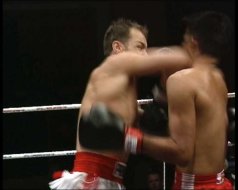
"Krabi
Krabong" :
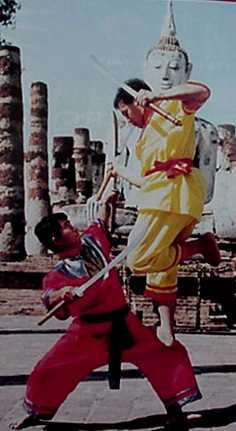
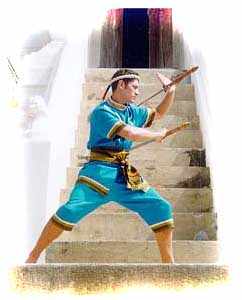
This ancient method of fighting combines both weapons (Krabi-Krabong, which roughly translated means "sword - long staff") and empty hand techniques (Muay Thai). However, Krabi-Krabong is primarily a weapons based art. Its training utilizes many weapons including knives, shields, mai-soks, spears, dang, axes, single and double swords, as well as the long staff.
Krabi-Krabong is the original martial art of Thailand. In fact, Muay Thai (Thai Boxing) actually evolved from this ancient art. This art teaches one all the ranges of fighting - from long range weapons to close combat. Krabi-Krabong highlights traditional forms and fighting techniques of south east Asia.
The Fighting Kingdom of
Siam
Wherever one may wander in the Orient among the many schools of fighting arts one will not find a deadlier group of combatants than the Kickboxers of Thailand. Many great master's in the martial arts accept that the Thai Boxer is lethal, because he is a professional and lives just to fight. Many people look upon Muay Thai (correct term for Thai boxing) as a sport. This may be partly true, but the legacy of this 2000 year old art lives on today in the hearts of the Thai people. One visit to Thailand will confirm this. Down any street one cane see young children going through the rudiments of this ancient Siamese fighting art.
Muay Thai's Early Rise
The old Kingdom of Siam, as Thailand was once known, has from ancient times always seen trouble from its neighbors. Occupying the Southeast Asia peninsula, it has Burma on the west, Laos on the north and east, Cambodia to the southeast, and the Gulf of Siam and Malaysia on the south. Yet amazingly this "Land of the Free" has resisted all attempts to conquer it. One can only put this down to the fierce fighting spirit of the people. Muay Thai techniques were part of the military training system, which was greatly influenced by Chinese fighting methods in the beginning. It later underwent a marked change and developed independently, losing many of the Chinese boxing methods along the way. It is somewhat of a mystery how and why this happened, and for that matter why many of Muay Thai's special fighting techniques are not seen anywhere else outside Thailand.
The Tiger King
Because the Siamese people were combative by nature, the common folk picked up the military unarmed fighting methods and developed them into a sport, but they still retained all the lethal blows. Further skills were developed during the reign of king Pra Chao Sua, who was known as the Tiger King. Every village staged its prize fights, with young and old, rich and poor all taking part. The King himself was a high skilled boxer and was reputed to have trained with his soldiers six hours a day. He would often leave his palace disguised as a wandering peasant and enter boxing events, always defeating the local champions. The King would spend hours alone in his palace perfecting certain techniques, and then try them out in local contests. So skilled were some of his boxing strategies that even today they are still used and known as the Tiger King Style.
The Greatest Fighter of Them All
Over the centuries the greatest of the Muay Thai fighters have become legendary. Stories are told of their battles and adventures to eager listening children by the village story tellers. Perhaps the most famous of all Siamese fighters was Nai Khanom Tom. He was a brilliant athlete and a strong courageous man, holding the title of the best fighter in all Siam. During the many wars that Siam had with her neighbor Burma, Nai Khanom Tom was captured by Burmese soldiers. They had heard of his great fighting ability so they decided to pit him against 12 of Burma's top bando fighters (Bando is a martial art of Burma and similar to Thai Boxing), and if he could defeat all 12, Nai Khanom Tom would be allowed to go free.
So the next day in a stadium packed with thousands of people, Nai Khanom Tom prepared to fight bare handed against the cream of Burma's top fighters. One by one they came at him, all out to hurt him and become heroes themselves for defeating the greatest martial artist in Siam. As each fighter pitted his skills against the great Nai Khanom Tom, he was instantly injured and unable to continue, being dispatched with lighting elbow strikes and murderous knee blows. As the day word on, the great Siamese champion had defeated all of his opponents. The spectators, who had been cheering fort their own men, suddenly began to cheer for this magnificent fighter from Siam. They were full of admiration for the prisoner who had fought and defeated several men without rest or being wounded himself. The King of Burma had no alternative but to let him go free.
No Rules or Regulations
In 1930, Muay Thai underwent a transformation. A number of rules and regulations were introduced including the wearing of boxing gloves and groin guards. Certain weight divisions were stipulated. Until that time, virtually anything was allowed in the ring. One favorite device used by the boxers was hemp tope bound around the fist to act as a form of glove. Then it was dipped in glue and rolled in finely ground glass.
Growth of the Art Today
With the spread of contact sports among martial artist throughout the world, Muay Thai has burgeoned all over the world. In Japan, Europe, and North America, Muay Thai has reached epic proportions in recent years. Followers of many other martial art disciplines will on most occasions refuse to fight a Thai Boxer because they regard him or her as a complete fighting machine.
American Kickboxing / Full Contact Karate :
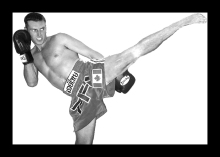 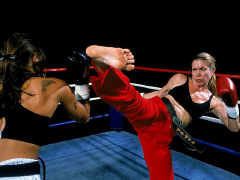
Full-contact karate first surfaced as American kick-boxing in January 1970 when
Joe Lewis (known as the
Father of American Kickboxing), influenced by his training sessions in boxing and with Bruce Lee, staged the first contact bout, knocking out Greg Baines to become the first heavyweight champion.
The seventies is where point karate had it's highest peaks of quality competitors and events. This is also the time period of another group of competitors that emerged as the cutting edge of
kick boxers. First, the emergence of the second generation of point fighters. These names were a mixture of point karate and full contact karate fighters. They are as
follows :
Demetrias Havanas, Roy Kurban, Bill Wallace, Jeff Smith, Jim Harkins, Pat Worley, John Worley, Mike Warren, Max Alsup, Jim Buton, Al De Cascas, Blinky and his brother Benny Urquidez. All of these fighters were the best of the best in the point karate arena. For the majority they all attempted the transitions from point karate to full contact karate. Some of the warriors made the transitions and the others stayed in the point karate arena. This particular era of karate was the one that the actual teachers of the Full Contact Karate in America were born. The students of these great ones were the ginny pigs of kickboxing. They started their adventure as the sparring partners of the true pioneers.
Some notable names in Kickboxing are :
Joe Lewis, Bill Wallace, Pat Burleson, Skipper Mullins, Jack Hwang, Fred Wren, Chuck Norris, Roger Carpenter, Jim Harrison, Mike Stone, Bruce Lee, David
Moon. These names dominated the karate competition circuit of the sixties and for some also into the seventies.
Note : Bill Wallace began
training differently around 1973. Joe Lewis was the first coach of Bill
Wallace.
Some KickBoxing Masters/World Champions [Joe
Lewis & Bill Wallace]
World Champion & Father of
American KickBoxing -- 'Joe Lewis' :
First kickboxing in this hemisphere was
Lewis first match, 1970 in Long Beach against Greg Baines. It was billed "full contact" but upon entering the ring, it was called by the
announcer as kickboxing.
Maung Gyi opened the first kickboxing school in the U.S. in D.C., 1963. Master Thong opened the first Thai boxing school in the U.S. in Springfield, Mo, 1970.
Joe Lewis
is the "Father" of the sport, having the first pro match in Long Beach, Ca 1970.
Anderson and Joe Lewis set up the first World Championship in 1974, not 1975. All full contact techniques were
allowed.
 --->Joe Lewis
--->Joe Lewis
Joe Lewis became the first martial artist to win a world championship in two different sports: point-fighting karate and full-contact kickboxing. He is a Black Belt Hall of Fame member in two categories: Competitor of the Year and Instructor of the Year.
Lewis began his training in Okinawa studying with three instructors: Eizo Shimabuku, Kinjo Chinsaku and Seiyu Oyata and he also studied with the late great Bruce Lee. He received his Black Belt in Shorin Ryu and studied several different styles. He never believed in "style" to him they were all the same..."punching and kicking."
Lewis was a member of the first combat unit in Viet Nam, 8th Marine Brigade, 1965. One of the first Americans to teach Hand to Hand Combat in Viet Nam working with Division Recon. "The Greatest Karate Fighter of All
Time", Lewis is best known for being World Champion in 2 separate sports, Karate and Kickboxing, plus being the founding father of Kickboxing in the Western Hemisphere.
Lewis got involved in Martial Arts in 1962, where he took judo lessons in the Marine Corp. He had also studied a few of the Okinawan styles, including the ones dominant to the area at that time, Shorin-Ryu, Shorei-Ryu, and Goju-Ryu, just to name a few. He had always been intrigued by anything that required any kind of physical efficacy, and athletic people who could move fast, or lift double their body weight impressed him. So when he first began looking into the Martial Arts, speed and power were two attributes he definitely looked for. He had been unimpressed by the Okinawan styles, however, for they all looked the same to him, all kicking and punching. So began his search for his "perfect" Art.
Finally, after his rather difficult search for the specific qualities he wanted, he heard about a man by the name of John Korab, who eventually, in 1964, became the first American to ever teach him to fight. He had earned several different Black Belts overseas while serving in the Marine Corp, but it is the Americans whom he gives credit to for teaching him how to fight.
A board of four 10th Degree Black Belts, two of them Jiu Jitsu stylists, and two of them Karate stylists, promoted Mr. Lewis to his 10th Degree Black Belt in his style, which he calls American Karate/Kickboxing. However, he does not believe in any particular "style" of Martial Arts, for he believes that there is too much emphasis on style, and not enough on body conditioning. To most people, what dictates one’s style is the type of katas they do. But to Mr. Lewis, style is much, much more. He believes it has to do with a person’s personality, their fundamental base, their physical makeup, and what kind of opponent they are up against. He believes that is truly a person’s style.
Joe Lewis’ fighting style is called the 'Joe Lewis Fighting
Systems', plural because he teaches a combination of ground fighting, and full-contact Kickboxing, taking what he believes to be the elite of every style and incorporating it into a full system - a system that is constantly evolving, gaining new concepts and new ideas from the other styles out there. Mr. Lewis himself spends most of his time developing new fighting drills. He doesn’t actually have a chain of schools, but rather, he teaches trainers how to produce world class fighters.
He believes that to be a true fighter, you should prove that you can go at least ten to twelve rounds against a very competent opponent, and you should also be able test your will to continue, which a lot of fighters have never been in a situation to do.
Lewis hit the scene-at least for those martial artists attempting to contend for a championship. Lewis wore a nice-fitting gi (uniform) and didn't look grungy or sloppy. He didn't drink alcohol, coffee or tea, and he didn't smoke. But he did bring speed, power and finesse into the sport, along with the discipline and training habits of a professional athlete.
Here stood a big guy with a chiseled frame who was flexible and could kick as hard as anyone had ever seen. He was lightning-fast with his lead-leg side kick and even quicker with his backfist and reverse punch. His footwork was smooth, balanced and swift. Additionally, he was very disciplined when it came to defense. In an entire day of tournament fighting, no more than a couple points would be scored on him, and often he would not give up even a single point !.
He says his focus is on self-reliance and development, and his approach to teaching is for the student to "be like a scientist on the cutting edge of research, with his or her thinking rooted in, but not bound by, the best knowledge currently available." This philosophy has helped remove some of the barriers from those locked into methods or techniques that are antiquated or simply do not work.
Lewis' combat system is composed of some of the most revolutionary fighting strategies ever. They were developed after years of research and experience. These strategies have all been put through many practical tests, either in the ring or on the mat.
Master /World Champions -- 'Bill Wallace'
["SuperFoot" !] :
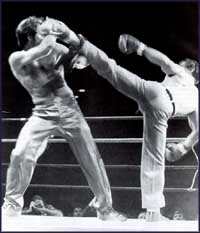 .jpg) -->
Bill on left doing a block on punch.. -->
Bill on left doing a block on punch..
Bill Wallace on right doing a snap kick with his left leg !
Bill Wallace was one of the greatest tournament fighter. He made history using an unorthodox style to accumulate 23 consecutive professional full-contact karate victories. He is a
three time Black Belt Hall of Fame member: two-time Competitor of the Year and one-time Man of the Year.
Note : Bill Wallace began
training differently around 1973. Joe Lewis was the first coach of Bill
Wallace.
One of Bill Wallace's gifts to the martial arts world was that he taught folks how to "really kick."
He helped people become aware of what ballet dancers and gymnasts have always known-that flexibility is vital for developing good skills and for avoiding layoffs caused by pulled muscles and other injuries. He devised ways to stretch out the hamstrings, quadriceps and abductors, all of which are involved in kicking. He then developed ways to strengthen these muscle groups and created endurance exercises for them.
In a world where the smaller guy would always get run over by the bigger guy, Wallace made it possible to overcome a larger or stronger opponent-not only for himself, but for the masses who wanted to learn his secrets. One of Wallace's most noble attributes was that he freely shared the secrets of his success while still defending his world kickboxing title, and that included teaching fighters who were potential conten ers or his championship.
"Superfoot" Wallace was the undefeated Middlewieght Kickboxing Champion of the World.
Bill Wallace retired as the undefeated Professional Karate Association (PKA) Middleweight Champion after defeating Bill Biggs in a 12-round bout in June 1980. Ending Wallace's fifteen year career in karate, this bout also marked his twentieth consecutive victory (with 11KOs) in full contact competition.
The name "Superfoot" comes from the awesome power of his left leg, which once clocked in excess of 60 mph. Wallace began studying karate in 1967 after an injury to his right leg in a judo accident. The accident left him without the use of the leg for competition. However, over the next seven years, "Superfoot" dominated the point-tournament circuit. As a national champion point fighter three years in a row, Wallace captured virtually every major event on the tournament circuit including: U.S. Championships (3x), the USKA Grand Nationals (3x), and the Top Ten Nationals (2x). In 1973, Wallace suffered another potential career-ending injury. His incredible comeback included capturing the PKA middleweight karate championship in 1974. Despite his retirement, Wallace continues to be one of the most popular figures. He is a former member of the President's Council on Physical Fitness plus an author of 3 books and a series of videos.
Bill Wallace also began his martial arts training in shorin-ryu karate. It was sort of by accident that he got into karate because originally he was an exceptional judo player with a background in wrestling. He got his start in judo while in the U.S. Air Force, and in 1966 he had the misfortune of sustaining a career-ending injury at least as far as competitive judo was concerned. He completely ripped the ligaments in his right knee. While his knee was healing, Wallace seized the opportunity to get into karate and decided to "just do it." He trained with some positive and committed people at a school in Okinawa's Naha city, and, like Lewis, he made short work of earning his black belt.
he suffered a knee injury during his career that would have forced him into retirement unless he found a way around it. He found this way by using only his healthy, left leg for kicking and used the right one as a support leg. By keeping a modified horse stance and fighting sideways, he always had his strong side facing the opponent and kept his weak leg out of reach. He used only 3 kick, but managed to be very effective with them.
Bill explains some important factors for making his style of kicking work : Chambering all kicks into the same position, snapping kicks instead of thrusting them and emphasizing speed over power.
Bill "Superfoot" Wallace is one of the most recognized American Martial artists around. He was a successful Karate point fighter, before he turned to full contact competitions. What made him such an icon in the USA is a combination of factors: First of all, he turned a handicap into an advantage and therefor accomplished the "American dream". Second, he was the Karate instructor of Elvis Presley. And third, he has kept himself in outstanding physical condition throughout the years. These factors are then combined with World Champion titles and the result is a myth in the making. The several appearances Mr. Wallace made in motion pictures and television series have only contributed to his success.
Once Wallace switched to full-contact karate, he became an even bigger name by becoming the Professional Karate Association middleweight world champion. He won 23 consecutive professional fights between 1974 and 1980. He retired undefeated.
Bill Wallace side kick !

Joe Lewis and Bill Wallace are the most sought-after instructors and speakers on the martial arts seminar and training-camp circuit.
INTERNATIONAL RULES FOR INTERNATIONAL KICKBOXING OR TRUE KICKBOXING :
Shorts only - No Pants!
Footpads and shin pads are not required but may be used.
No strikes are allowed to the groin or joints of the leg.
During matchmaking, it will be determined if kicks are allowed to the outside OR inside and outside of the front leg only OR the front and the rear leg with the shin or the foot.
Pro-World Title bouts 10, 2 minute rounds and 1 minute rest between rounds.
Pro- Intercontinental and Continental Title bouts; 8, 2 minute rounds with 1 minute rests.
Pro- National, Title bouts: 7, 2 minute rounds with 1 minute rests.
Pro- State and Regional Title bouts: 6, 2 minute rounds with 1 minute rests.
Pro- Non Title bouts: 5, 2 minute rounds with 1 minute rests.
Amateur- There are no Amateur World Title Bouts.
Amateur- Intercontinental, Continental and National Title bouts: 5, 2minute rounds with one minute rests.
Amateur- State and Regional Title bouts: 4, 2 minute rounds with 1 minute rests.
Amateur- Non Title bout: 3, 2 minute rounds with a 1 minute rests.
Note :
To me traditional Kickboxing is the most practical of all the arts, I mean no disrespect to any one or other styles, but it is. Think about it why do the majority of people
practice martial arts, well from the people I've asked the answer I get most commonly is: they do it for self-defence. Now, what is the best form of defence? A strong offence, which art is most known for it's strength and destructive power? Answer traditional Kickboxing. What is traditional Kickboxing you ask, well it's Muay Thai or Bando; these are the original Kickboxing styles of the eastern countries. Muay Thai originates from Thailand and Bando Comes from Burma; both are very similar and very powerful.
Here are
some of my KickBoxing training pictures..
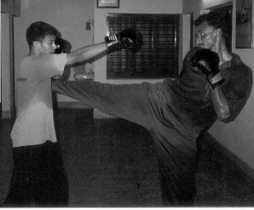
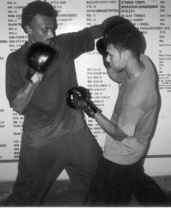
Here's me
kicking..
Here doing a punch on temple with left hand hook..
Bando or Thaing :
This is a Burmese martial art with both armed and unarmed techniques. It emphasizes an initial withdrawal, followed by an attack outside the opponent's reach. Once the initial attack is delivered, grappling and locking techniques are applied. Bando practitioners use all parts of the body in the delivery of attacks. The term Bando is translated as either "way of dicipline","system of defense", or "art of fighting, or combat." Swords, knives, spears, and sticks are sometimes used, and the art is similar in many ways to its neighboring martial art Muay Thai.
Some Bando groups have combined all three translations in one, making it similar to the Japanese term Budo (stop conflict), the Chinese word Wu Shu (war art), or the English terms military arts or martial arts. Some etymologists believe the term Bando derives from Chinese, while others claim Indian or even Tibetan origins. Bando is also called
"Thaing."
History :
Like Thailand, Burma, its neighbor, developed systems of unarmed fighting hundreds of years ago. Since India and China are two of its neighbors, it is not surprising that the evolution of unarmed fighting techniques owed much to India and China.
As in the case of China, Buddhist monks had much to do with the development of the fighting arts in Burma. There are many legends about Buddhist monks teaching students the martial arts in secret. In those days, it was unwise to make public one's fighting techniques. Once a technique became public property, it was no longer as effective as before. This is because there would be counters invented to neutralize the techniques. Therefore it was safer for the monks to teach their martial arts in the close secrecy of the monastery.
Ancient writings reveal that as far back as the time of King Anawratha (1044 - 77 A.D.) Buddhist monks were teaching the secrets of breath-control and mediation practice in addition to the principle of yielding of force – a principle that seems to be found in arts like Tai Chi, Aikido, and even Judo.
But the bando system is not all of Burmese martial arts. The overall name is actually 'thaing'. This word is Burmese for 'self defense'. The term is the equivalent of the Chinese term 'wushu'.
Among the arts of unarmed combat listed under the term 'thaing' are:
• Bando
• Lethwei or Burmese Boxing
• Naban or Burmese wrestling
These are the basic divisions in the world of unarmed combat in Burma.
As a result of contact with the Japanese, the bando art of fighting evolved into a much more lethal system of empty-hand fighting.
Like karate and the other forms of martial arts, there are many styles of bando fighting. Despite the variety, it is possible to trace certain basic similarities in all the schools of bando fighting.
Training Levels
All bando schools start off by teaching the basic stances and the footholds – just as in kung fu or karate. This preliminary stage of training lasts for several months. In some cases the first stage might drag on for years, depending on the instructor or the style of bando being taught.
In the second stage of training, the bando student has to go through a whole arsenal of blocking and parrying techniques. At the end of this stage, the student is fairly well equipped for defending himself against unarmed attackers. But he cannot be regarded as a full-fledged fighter.
The final stage involves the learning of offensive techniques. Before the student learns these techniques, the master makes sure that he will not abuse his knowledge. This cautious attitude towards the learning of the martial arts was probably derived from the Chinese tradition of martial arts instruction. There have been many cases of students abusing their acquired skills to the extent that sometimes the masters are threatened.
Various Names of the Forms
Animal names are used to denote some of the forms that can be found in Bando. This probably comes from the Chinese influence. There are forms called Boar, Bull, Cobra, Deer, Eagle, Monkey, Panther, Scorpion, Tiger and Viper.
The names indicate the characteristic of the forms, which they denote. Thus the Python form includes crushing, strangling and gripping moves while the Tiger form applies quite aptly to maneuvers, which involve clawing, and ripping. The Deer form has been given that name because it is meant to develop alertness in the bandoist.
Bando fighting generally leaves the initiative to the opponent. It is a style of combat that relies heavily on countering moves. Thus when attacked, the bandoist would first withdraw and then would begin the counterattack.
Bando attacks include much handwork directed at the body. But the bandoist does not neglect using head, shoulder, elbow knee, and foot for offensive purpose. Attacking the private parts is also a favorite technique with bandoists.
The techniques of bando fighting are learnt mainly through the practice of forms and with partners. The final stage of mastery includes participation in contests, which sometimes end in deaths.
CHI: 1
WILLPOWER: 6
PUNCH:
Elbow Smash(1)
Head Butt(1)
Spinning Back Fist(1)
Triple Strike(1)
KICK:
Double Dread Kick(3)
Double Hit Kick(1)
Double Hit Knee(1)
Flying Knee Thrust(1)
Foot Sweep(1)
Wounded Knee(2)
BLOCK:
Maka Wara(3)
GRAB:
Head Butt Hold(2)
Knee Basher(2)
Joint Lock(1)
Pin(2)
Improved Pin(3)
ATHLETICS:
Jumping Shoulder Butt(1)
Flying Head Butt(2)
ARMED:
Dashing Strike(4)
Double Hit Strike(1)
Lunge(2)
Spinning Back Strike(1)
Some tips on Jump Kicks/ Airborne Kicks from
'Hector Echavarria' :
Hector Echavarria, an Argentinean expatriate who garnered an impressive record of 25-0-1 (24 by knock-out) in the kickboxing ring. He attributes more than a few of his victories to his airborne foot techniques.
Jumping Front Kick:
The jumping front kick should begin from a fighting stance that does not betray your intentions, Echavarria says. "It should look almost like you are going to punch or do a regular move. It's best if you can do the kick from a natural position."
"You simply spring off the ground and bring the knee of your kicking leg right up in front of your body," Echavarria says. "Then you kick while you keep one hand close to your face and the other close to your body for protection."
You should not hesitate to throw the jumping front kick as soon as you see an opening, Echavarria says. "You have to train until your techniques become second nature. If you have to choose which kick to throw, it's too late. Most likely, you'll be on the floor."
Jump Spinning Side Kick:
When you are ready to execute the jump spinning side kick, start from a neutral stance and wait for an opening to use it as a counterattack, Echavarria says. "For example, if he throws a left cross, you can jump and spin as the punch comes towards you. When you do that, your left hand must protect your face and your right arm should protect your body."
"When you are training, the safest targets are the stomach and sternum, but in competition you can go for the face, too," Echavarria says.
Jumping Roundhouse Kick:
To perform the jumping roundhouse, once again you should start from a neutral stance. Always use your arms to protect yourself when you jump, Echavarria says.
"This technique has a trick: If you hit your opponent with your foot, you will hurt him but not that much," Echavarria says. "It is better to use your shin to strike. That will add to your power. Aim for his nose or forehead. If you hit him with your shin, you can easily cut him."
One of the best ways to employ the jumping roundhouse kick is as a set-up, Echavarria says. "You want your opponent to lean forward so you can meet him while you're on the way up. To get him to do that, you can fake a cross to his body. That will enable you to bend your legs before you spring upward and hit him as he bends forward."
Jumping Side Kick:
Before you execute the jumping side kick, you should assume a fighting stance that does not telegraph your counterattack intentions. "If he throws a right cross, you can force his hand down with your lead hand, leaving his chin exposed," Echavarria says. "From there, you jump and kick over his hand. It's almost like you trick him into getting kicked."
"If you do it correctly, the jumping side kick can be very effective because of what happens when you bring your knee up in front of your body," Echavarria says. "When your leg is cocked, it shields your whole body while you are airborne. You are protected until the moment your heel is thrust into the target."
Jump Spinning Split Kick:
The jump spinning split kick is one of the most difficult and flashly maneuvers in the martial arts. Nevertheless, it does have its uses on the silver screen and once in a blue moon in the ring. "If you feel like you can do it, give it a shot," Echavarria says. "But realize that you have to spin more than 180 degrees before you kick. To do that, you must jump and lift your knees up high, almost touching the bottoms of your feet. From that tucked position, you will be able to spin faster."
Once you have rotated, you must throw one foot toward the target and the other in the opposite direction, Echavarria says. "The problem is that your hip is spinning and the only power you have comes from extending your leg. The kick is flashy but not powerful. For most martial artists, its best use will be in demonstrations and movies."
Street Fighting :
Martial artists often over-analyze a situation. They'll take something like street fighting, which is very dynamic and changing, and try to dissect it and completely map it out. There are no absolutes in a street fight - nothing is pure. In a fight you aren't going to always be able to use pure grappling, or pure punching, or even pure kicking. But every one of these techniques -- including high kicks -- have a definite place in a fight and can be used depending on the situation you're in. So don't get brainwashed into taking a very important part of a martial artist's repertoire - the high kick - out of your arsenal. Practiced in the right way, and used with surprise or with the proper set up, the high kick, like the knock-out punch in boxing, can be used to end a fight right here, right now, and get you out of a dangerous and potentially life-threatening situation with a minimum amount of risk."
Vale Tudo vs. Street Fighting:
"There are many street-fighting techniques that will get someone off you," Echavarria says. "For example you can fishhook someone's mouth with your finger until the skin tears. You can go for the eyes, the throat, and the ears. So what I'm saying is that it is very important to be aware of the things that people say, and then look at the actual situation they will use their techniques. A street fight is not a vale tudo match. I have seen this many times in Argentina. You don't stand apart and wait for someone to say, "Let's get it on!" You start when you start and if you win, you win -- if you don't win you go to the hospital. No one's going to start screaming, "Hey, no fair! He used a fishhook!" You're fighting for survival, and you're lucky if someone doesn't pull a knife on you. So the UFC and other types of NHB (no-holds-barred) events aren't close at all to a real street-fight. If anything, NHB rules are oriented towards grapplers, not strikers. I have seen a lot of fights where the guy who knew how to high kick correctly ended the fight in a matter of seconds. It never got close to going to takedown and
ground fighting range.
Some useful links :
Good KickBoxing Articles by "Hector Echavarria" ! : http://www.echavarria.com/articles.htm
Basic clips to learn KickBoxing ! : http://whitecollarboxing.com/KickboxInstruction.htm
Kickboxing Lessons in Video clips : http://whitecollarboxing.com/WCBKickboxLesson1.htm
Some classic KickBoxing Video Clips ! : http://whitecollarboxing.com/Fights.htm
Please click below to see some Kickboxing pictures :
http://www.mikemiles.com/pics/edi12.JPG
KickBoxing Rules : http://www.vipers.co.uk/kickboxing_rules.htm
More about Superfoot Bill Wallace at : http://www.superfoots.com/superfoot.html
Muay Thai TERMINOLOGY : http://web.ukonline.co.uk/phraya-pichai/muaythai/terminology.htm
History of Muay Thai : http://web.ukonline.co.uk/phraya-pichai/muaythai/emptyhands.htm
Here are some pictures of Muay Thai legends :
http://www.q-net.net.au/~dazsal/modernledgends%20pge.html
Some good Muay Thai Pictures :
http://www.almeria.itgo.com/wayne.jpg
http://www.almeria.itgo.com/rammuay7.gif
http://www.almeria.itgo.com/rammuay13.jpg
http://www.almeria.itgo.com/rammuay1.jpg
http://web.ukonline.co.uk/phraya-pichai/gfx/mtweapons1.jpg
More about Bill Wallace at :
http://www.superfoot.com/
http://users.pandora.be/wim.demeere/book/book001.htm
For more info in Joe Lewis : http://www.joelewiskarate.com/
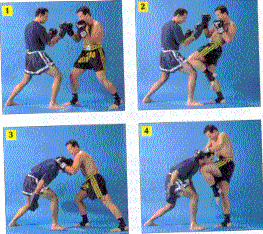
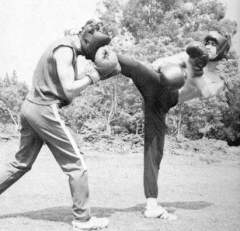 Bruce
Lee on right ! Bruce
Lee on right !
  
|















 --->Joe Lewis
--->Joe Lewis

.jpg) -->
Bill on left doing a block on punch..
-->
Bill on left doing a block on punch..



 Bruce
Lee on right !
Bruce
Lee on right !